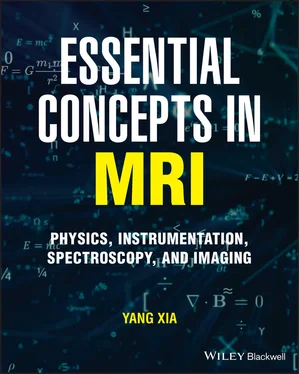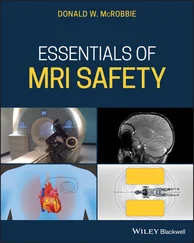Yang Xia - Essential Concepts in MRI
Здесь есть возможность читать онлайн «Yang Xia - Essential Concepts in MRI» — ознакомительный отрывок электронной книги совершенно бесплатно, а после прочтения отрывка купить полную версию. В некоторых случаях можно слушать аудио, скачать через торрент в формате fb2 и присутствует краткое содержание. Жанр: unrecognised, на английском языке. Описание произведения, (предисловие) а так же отзывы посетителей доступны на портале библиотеки ЛибКат.
- Название:Essential Concepts in MRI
- Автор:
- Жанр:
- Год:неизвестен
- ISBN:нет данных
- Рейтинг книги:5 / 5. Голосов: 1
-
Избранное:Добавить в избранное
- Отзывы:
-
Ваша оценка:
- 100
- 1
- 2
- 3
- 4
- 5
Essential Concepts in MRI: краткое содержание, описание и аннотация
Предлагаем к чтению аннотацию, описание, краткое содержание или предисловие (зависит от того, что написал сам автор книги «Essential Concepts in MRI»). Если вы не нашли необходимую информацию о книге — напишите в комментариях, мы постараемся отыскать её.
A concise and complete introductory treatment of NMR and MRI Essential Concepts in MRI
Essential Concepts in MRI
Essential Concepts in MRI — читать онлайн ознакомительный отрывок
Ниже представлен текст книги, разбитый по страницам. Система сохранения места последней прочитанной страницы, позволяет с удобством читать онлайн бесплатно книгу «Essential Concepts in MRI», без необходимости каждый раз заново искать на чём Вы остановились. Поставьте закладку, и сможете в любой момент перейти на страницу, на которой закончили чтение.
Интервал:
Закладка:
My special thanks go to several colleagues who contributed directly to this book: Bradley J. Roth (Oakland University) and Siegfried Stapf (Technische Universität Ilmenau), who generously offered to read and comment on a draft of this book; Dylan Twardy (Oakland University), who worked with me during a previous semester to obtain some NMR spectra that are used in the book and also read the spectroscopy chapters; Roman Dembinski (Oakland University), who read the spectroscopy chapters in this book; and Farid Badar (Oakland University), who provided several image examples used in the book. I also thank the students in my classes over the years (in particular, several students in my most recent class, who had the opportunity to use an early version of the typed notes); all of you have made this book better.
My final thanks go to my sister, Xing, my daughter, Aimee, and son, Derek – you have successfully kept the homebound me during the 2020 pandemic sane and productive. You see, I had dreamed about publishing my lecture notes as a book for some 15 years. I started on this journey several times in the past, and each time I dropped it without completion due to the onset of a few work-/family-related tasks. Yes, these were excuses, I know! When this pandemic started in the beginning of 2020, I had to prepare to teach this course online. After I transcribed the mostly handwritten notes onto a home computer, I kept revising it using the lockdown months when I was working from home. So, here it is.
To my readers, I would love to hear from you, for any corrections and suggestions you might have.
Yang Xia 
Distinguished Professor
Professor of Physics
Fellow of the American Physical Society (APS)
Fellow of the International Society for Magnetic Resonance in Medicine (ISMRM)
Fellow of the American Institute for Medical and Biological Engineering (AIMBE)Fellow of the Orthopaedic Research Society (ORS)
Department of Physics
Oakland University
Rochester, Michigan, USA
xia@oakland.edu
micromri@gmail.com
The first draft 2020.8.2
The second draft 2021.1.20
The final revision 2021.3.31
1 Introduction
1.1 INTRODUCTION
This book explores the physics phenomenon that provides the foundation for and the engineering architectures that facilitate the widespread applications of nuclear magnetic resonance (NMR) spectroscopy and magnetic resonance imaging (MRI). NMR is the physics phenomenon at the basis of every MRI experiment. The first word, “ nuclear, ” refers to the core player of this phenomenon – stable atomic nuclei. The protons in a common water molecule are the most useful nuclei because of their high sensitivity and simplicity. Please make a note that when we say proton in NMR and MRI literature and in this book, we mean hydrogen atom , not the nucleon . Since these nuclei are stable, there is never any radioactivity in NMR . The second word, “ magnetic, ” refers to the environment that these nuclei must have – the nuclei need to be immersed in a magnetic field, which can be generated in several ways including the use of a permanent magnet. The third word, “ resonance, ” refers to a concept in physics where a system has the tendency to oscillate at the maximum amplitude at a certain frequency f (Figure 1.1). This resonance system can be mechanical (e.g., the pendulum studied by Galileo Galilei in 1602, and the collapse of several suspension bridges in Europe in the 1800s by marching soldiers), acoustic (e.g., many musical instruments), and electromagnetic (e.g., an electronic receiver in your radio and television). To receive the signal from a particular channel or station among the tens or hundreds of channels and stations available, the resonant frequency of a receiver in a radio or television set is adjusted either manually by turning a knob/dial in an analog circuit of a classical (i.e., pre-digital) radio or TV, or by scanning automatically over a range of frequencies in digital receivers. When the right frequency is met, the signal can reach the maximum.

Figure 1.1 The resonance phenomenon, where the signal amplitude reaches a maximum at a particular frequency f0.
Let us clarify the terminology of the NMR phenomenon, since it has several acronyms as well as sub-fields. NMR is the original and full name of the phenomenon, which now commonly refers to its physical principles. NMR spectroscopy is the spectroscopic application of NMR, which seeks the chemical information in the process; this term is used commonly in basic science and in particular in physics and chemistry. NMR imaging is the imaging application of NMR, which mainly seeks the spatial information in the process; this term is used mainly by the non-medical imaging community. MRI is identical in content to NMR imaging, which is the term that is commonly used in the medical community (and by everyone else who is not in basic science). Microscopic MRI (µMRI) and NMR microscopy are the high-resolution versions of MRI.
1.2 MAJOR STEPS IN AN NMR OR MRI EXPERIMENT, AND TWO CONVENTIONS IN DIRECTION
The description of NMR and MRI theory would become easier if we first briefly overview what is involved in an NMR experiment. In general, an NMR or MRI experiment consists of three sequential “stages”: preparation, excitation, and detection. In the first stage, a sample is placed in an externally applied magnetic field B 0, which allows the nuclear ensemble in the sample (e.g., water molecules in humans or animals or plants or test tubes) to reach the thermal equilibrium state. This preparation stage results in a net macroscopic magnetization in the sample. In the second stage, a perturbation is applied to the sample in order to force the net magnetization away from the thermal equilibrium into a non-equilibrium state. Finally, the response of the net magnetization to this perturbation is recorded via the detector, where the recording is termed as the NMR or MRI signal. Final post-acquisition signal processing generates an NMR spectrum or an MRI image. These three sequential stages in an NMR or MRI experiment are controlled by a list of individual commands, and each occurs at a different time. This list of commands is called a pulse sequence. Chapter 5, Chapter 6, and Chapter 13will discuss the details of these instrumentational and experimental aspects.
A convention in NMR and MRI is that the externally applied magnetic field that is used to establish the net magnetization is always named as the B 0field, which is a vector field and has a direction always along the z axis (Figure 1.2), that is, B 0= B 0 k, where kin this expression is the usual unit vector along the z direction in a 3-dimensional (3D) Cartesian coordinate system. The direction of this z axis in Cartesian coordinates, however, can be either in the vertical direction (for vertical-bore superconducting magnets, which are common in research labs, or “open” MRI scanners, which reduce claustrophobia for some patients) or in the horizontal direction (for the electromagnets in research labs, the “vertical donut” magnet MRI, or the horizontal-bore superconducting magnets in common clinical MRI scanners).
Читать дальшеИнтервал:
Закладка:
Похожие книги на «Essential Concepts in MRI»
Представляем Вашему вниманию похожие книги на «Essential Concepts in MRI» списком для выбора. Мы отобрали схожую по названию и смыслу литературу в надежде предоставить читателям больше вариантов отыскать новые, интересные, ещё непрочитанные произведения.
Обсуждение, отзывы о книге «Essential Concepts in MRI» и просто собственные мнения читателей. Оставьте ваши комментарии, напишите, что Вы думаете о произведении, его смысле или главных героях. Укажите что конкретно понравилось, а что нет, и почему Вы так считаете.












